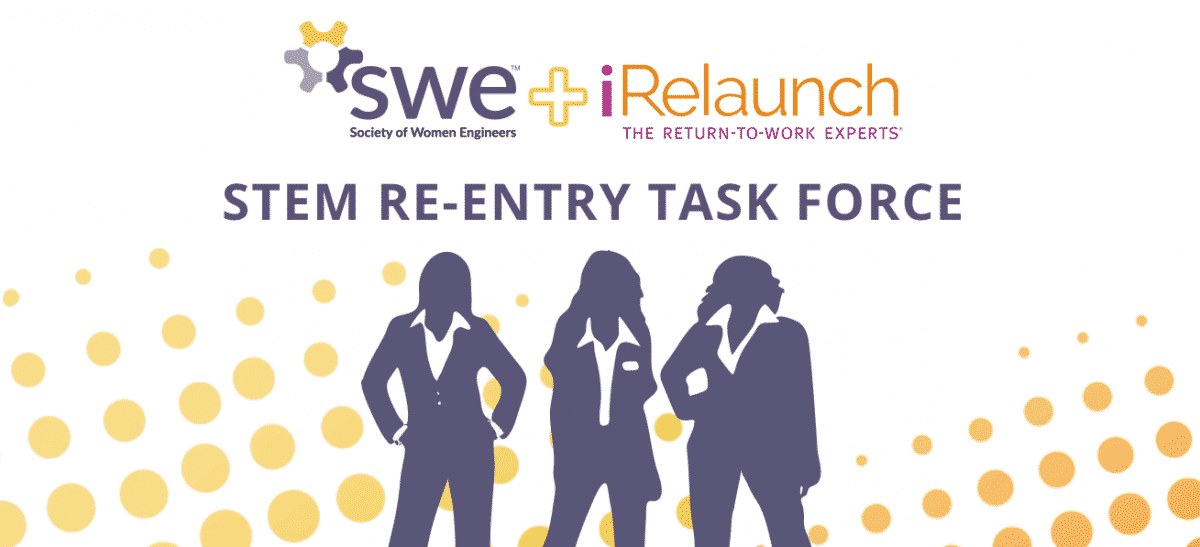Without intervention strategies, the current demand for technical talent combined with the projected increase[i] in the need for engineers will result in a significant shortage of skilled labor throughout the United States engineering industry.
Increasing the persistence of women in engineering at all stages of their careers is imperative to solving this talent shortage. As this white paper illustrates, while more women are graduating with four-year degrees than men, they are underrepresented in the engineering industry – especially within positions at the senior and executive levels. Women are also more likely than men to leave the engineering profession (Corbett & Hill, 2015).
In envisioning an intervention strategy to re-engage female engineers who have left the workforce, the Society of Women Engineers (SWE) and iRelaunch created the STEM Re-entry Task Force (Task Force).
Through the STEM Re-entry Task Force, engineering and technology organizations can develop cost-effective re-entry programs to attract an underutilized source of talent. (Within this context, re-entry programs are defined as formal internship programs developed by organizations to recruit individuals on a career break of two years or more back into the workforce to fill critical talent shortages. All re-entry programs are equal employment opportunities.)
Without incorporating re-entry programs as part of their overall recruitment strategies, organizations risk ignoring a valuable and largely unexplored source of talent. In addition, diversifying talent pipelines and increasing gender diversity not only addresses labor shortages, but it also fosters innovation (Dezso & Ross, 2012) and increases competitiveness in the global marketplace.
When the STEM Re-entry Task Force was launched in September 2015, Booz Allen Hamilton, Caterpillar, Cummins, General Motors, IBM, Intel Corporation, and Johnson Controls formally partnered with SWE and iRelaunch as Founding Members.
Through interviews with all active Founding Members of the Task Force, this white paper positions the specific need for re-entry programs within the context of each company while demonstrating the unique advantages received through participation in the program. These interviews also highlight the value proposition of the Task Force, provide key indicators of organizational readiness in starting a re-entry program and emphasize best practices and lessons learned. The conclusion provides specific recommendations to the engineering and technology sector.

SWE Releases STEM Re-entry Task Force White Paper — Key Outcomes and Indicators of Success
In the 18 months since its official launch, the STEM Re-entry Task Force has had demonstrated success:
- All of the Founding Members developed re-entry programs that launched or were poised to launch.
- All interviewed Founding Members that launched re-entry programs say involvement on the Task Force enabled effective development of their programs.
- All Founding Members interviewed for this white paper say participation in the Task Force supported their companies’ core values and was positively viewed by external and internal partners, stakeholders, and target audiences.
- Over 60 interns participated in Task Force pilot programs in the first year of the program (2016).
- Across all launched re-entry programs, the rate of converting re-entry interns to long-term employees ranged between 60 percent and 100 percent (meaning some companies hired 60 percent of their interns, while other companies hired 100 percent of them).
- Two companies that launched re-entry programs early in 2016 have already doubled or tripled the number of positions they plan to recruit for in the 2017 iteration of their programs. Another two companies developed re-entry programs for 2017 launch dates. One Founding Member launched a six-month program in 2016 that completed in early 2017, with plans to repeat the program in late 2017. Another one of the Founding Members launched a re-entry program in 2016 and is re-evaluating the future of the program.
- In the fall of 2016, a second cohort of the program began with the following organizations: Ford Motor Company, General Electric, Johnson & Johnson, Medtronic, Northrop Grumman Corporation, and Schneider Electric.
Jennifer Abman Scott, of SWE, and Carol Fishman Cohen, of iRelaunch, have co-led the execution of the Task Force since its inception. During the first year of the cohort, the Founding Members of the Task Force met during monthly conference calls and convened during SWE’s Corporate Partnership Council meetings. Companies also sent interns from the re-entry programs to share their experiences at SWE’s Annual Conference, WE16, which was held October 26–28, 2016, in Philadelphia, Pennsylvania, and was attended by over 11,700 individuals from all engineering disciplines.
This STEM Re-entry Task Force white paper was authored by Honna Eichler George, who conducted interviews and received content from Margaret Arney, Holly Rollins, and Cheryl Wade of Booz Allen Hamilton; Stacey M. DelVecchio of Caterpillar; Christina Baldwin and Karen M. Ramsey-Idem of Cummins; Silvia Karlsson, Catherine Martin, Kristen Siemen, and Adela Perez Vinot of General Motors; Jennifer P. Howland of IBM; and Catie Anderson, Cheryl Kern, and A. Denise Malloy of Johnson Controls. Jennifer Abman Scott and Carol Fishman Cohen provided both interviews and forwards for this white paper. Finally, SWE’s Deputy Executive Director and Chief Learning Officer, Peter Finn, provided editorial guidance during the final stages of this project.
As Executive Director and CEO of SWE, I am pleased to highlight the visionary leadership of the Founding Members of the Task Force in designing and developing re-entry programs that have increased their organizations’ access to high-caliber engineering talent. I also commend Jennifer Abman Scott and Carol Fishman Cohen in creating and directing the Task Force, which uniquely addresses a critical need within the engineering industry. In addition, the 2017 Cohort of the Task Force is furthering the impact of this intervention strategy by designing a new set of re-entry programs for their respective organizations. Finally, thank you to SWE’s Corporate Partnership Council, which provided seed funding to pilot the first cohort of the Task Force.
—
[i] In its analysis of employment rates detailed by occupation, the U.S. Department of Labor, Bureau of Labor Statistics projects a steady increase in the demand for engineers through 2024 (which is the current end year of available predictions).
Author
-
![SWE Releases STEM Re-entry Task Force White Paper [] SWE Blog](https://alltogether.swe.org/wp-content/uploads/2021/10/swe-favicon.png)
SWE Blog provides up-to-date information and news about the Society and how our members are making a difference every day. You’ll find stories about SWE members, engineering, technology, and other STEM-related topics.






